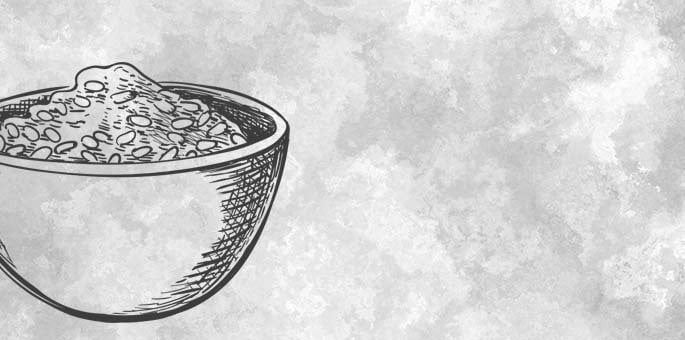The manna (in Hebrew, מן, which is more accurately transliterated as mon) was the miraculous edible substance that fell each day from heaven during the 40-year period between the Exodus and the conquest of Israel, providing our ancestors with sustenance throughout their travels in the desert.
A month after their exodus from Egypt, the Israelites’ food ran out, and on Sunday, the 15th day of the month of Iyar, they turned to Moses and Aaron for food. That night, a flock of poultry miraculously arrived, and the next morning, a special edible substance fell from the sky, which received the name “manna.”1 There is an opinion that although the people asked for sustenance on the 15th of Iyar, they still had a bit of food left, and the manna only began to fall three days later, on the 18th of Iyar (which would later become the day of Lag BaOmer).2
There are differences of opinion as to the source for the name “manna.” Some say that mon means a “portion of food”;3 others say it got its name because the first time the Jews saw it, they said mon, Egyptian for “what.”4
For more on this, see What Does “Manna” Mean?
Description and Sanitary Delivery
The manna was the size of a coriander seed and the color of a white bedolach, which commentaries explain is a fine crystal.5
In order that the manna remain clean, a north wind would blow, sweeping the ground, and then rain would wash it. The ground would then be covered with a layer of dew, and the manna would fall upon it, after which the manna was covered with another layer of dew, as if it were packaged in a box.6
Lessons in Faith—Limited Portion Sizes
The manna served as a great lesson in faith. Every day, enough manna would fall for each person to have an omer (approximately 43 oz.), which was enough to feel satiated for one day. One was not allowed to save the manna from one day to the next7—leftovers had to be discarded outside the tent,8 otherwise they would become wormy and inedible.9 This taught a great lesson in faith. Not having any reserves, the Israelites had to have full faith in G‑d that He would provide their needs each day.10
Double Portion for Shabbat
On the first Friday after the manna started falling, the Israelites went out and discovered that there was a double portion for each person. Moses explained that the extra portion was for Shabbat, the day of rest, on which no manna would fall.11 To commemorate this double portion, on Shabbat we make the Hamotzi blessing on two loaves of bread.12 This also serves as a reminder that just as the manna came from heaven, so, too, our livelihood is ultimately dependent upon G‑d.
For more on this, see Bread from Heaven.
Three Tiers of Delivery and Readiness
The manna would fall in such a way that the righteous would find it at the doors of their tents; the average people had to go out of the camp to gather what fell there; and the wicked had to go far out to find their portions.13
Additionally, for the righteous it fell ready-to-eat, similar to baked bread; for the average person, it fell as unbaked cakes, requiring minimal preparation; and for the wicked it came in an unprocessed form, and consequently they had to grind it in a mill.14
A person had until the fourth hour of the day to collect the manna, after which it would melt in the heat of the sun.15 The Midrash relates that the melting manna would create streams that provided drinking water for many of the animals in the wilderness. If a member of a nearby nation would then eat one of those animals that had drunk from the manna-infused streams, he would be able to get a taste of the manna.16
Taste and Nutrition
The Torah describes the taste as being similar to that of something fried in oil and honey. The manna was adapted to the taste of each individual; to the adult it tasted like the food of the adult, while it tasted like breastmilk for a baby. By wishing, one could taste in the manna anything desired, whether beef, fruit or grain.17
Interestingly, the Israelites later complained to Moses that they missed zucchini, watermelon, leeks, onions and garlic. If the manna could taste like anything in the world, why did they miss those vegetables? The Talmud explains that since these vegetables could be harmful to lactating women, the manna didn’t taste like them. Another explanation is that while it could taste like those foods, it wouldn’t take on their texture, as it did with other foods.18
Being a heavenly food, the manna contained nutritious matter only and was fully absorbed by the body, so after consuming it the Israelites didn’t needed to expel any waste products.19
Jewelry and Other Bonuses
According to tradition, together with the manna, all sorts of precious gems and pearls would fall.20 Additionally, it gave off a fragrant odor, and during the 40 years that the Israelites wandered in the wilderness, it served as perfume for the women.21
The Manna Used as a Means of Adjudication
The Talmud relates that the manna was used to adjudicate many quarrels. For example, if two people came before Moses for a judgment, one saying, “You stole my servant,” and the other one saying, “I did not steal him, rather you sold him to me,” Moses would say to them, “In the morning, there will be a judgment.” How was the matter resolved? If on the following day the servant found his omer of manna in his first master’s house, it would be clear that he was stolen, because the manna still came to the first owner. And if on the following day he found his omer of manna in his second master’s house, it would be clear that he had been sold.22
When the Manna Ceased to Fall
The manna fell for the 40 years that the Israelites were in the desert, ending following Moses’ death when they entered the land.23
A Jug of Manna Is Hidden Away
G‑d commanded Moses that a portion of manna be kept throughout the generations so that the Jews would see how G‑d sustained us in the desert. Aaron collected some manna and put it in a jar inside the Holy of Holies.24 The Midrash relates that it remained there for many years, and in the days of the prophet Jeremiah, when Jeremiah rebuked the Jews, saying, “Why do you not engage in the Torah?” they answered, “Should we leave our work and engage in the Torah? From what will we support ourselves?” He brought out the jar of manna and said to them, “You see the word of the L‑rd.”25 It does not say “hear” but “see.” In other words, Jeremiah was saying, “With this, your ancestors supported themselves. G‑d has many agents to prepare food for those who revere Him.”26
Our sages tell us that “when King Solomon built the Holy Temple, knowing that it was destined to be destroyed, he built a place in which to hide the Ark, at the end of hidden, deep, winding passageways.” Ultimately, 22 years before the destruction of the First Temple, King Josiah hid the jug of manna together with the Ark in that special hidden passage.27 According to tradition, it is still hidden there, waiting to be rediscovered with the advent of Moshiach.
The Midrash relates that this last bit of manna reminds us that just as in the desert, when the Jews were occupied solely with learning Torah, G‑d sustained them with the manna, so too, in the Messanic era, we will be sustained with food from heaven as we focus exclusively on delving into the Torah.28 May this be speedily in our days!









Join the Discussion